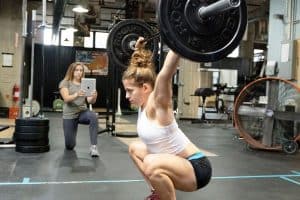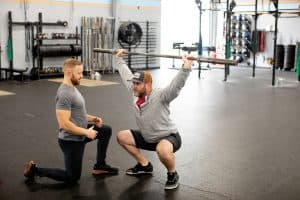
Since your initial injury, your mind is flooded with thoughts of getting back to your gym full speed. You’ve been longing for the day post-op to finally start Rx’ing workouts again. But yet you’re stuck drowning in anxiety from what you can and can’t do. Returning to snatches, kipping pull-ups, toes to bar, and muscle ups is a daunting challenge following surgery repairing a rotator cuff or labrum. For the past few months, you’re lucky if you’ve been lifting little more than red therabands and pink dumbbells. The contrast undoubtedly makes a full return to CrossFit after shoulder surgery seem an impossibly far way off.
At Onward Charlotte, we specialize in helping dedicated fitness athletes get back to the activities they want (and need) to do. In the sport of CrossFit, these movements are faster. They have heavier loads. They require more mobility than many other recreational activities. Getting back to where you want to requires a serious in-depth knowledge of the sport and guidance if you’re wanting to perform your best while staying healthy. Keep reading to uncover the five principles we suggest for returning to CrossFit after shoulder surgery!
1. Don’t Stop CrossFitting After Surgery
Step #1 is absolutely essential to us. We want you to stay as fit as possible after surgery, AKA: NO resting on the couch for 4 weeks. Sure, you will need to modify…maybe even a lot. But we’re not comfortable allowing you to let the other areas of your body become detrained. Your back squats will become belt squats. Your runs will become sled drags. You might even be on the rower using only one arm. Ultimately, you’ll continue working on being the healthiest version of yourself. We’re going to keep you doing the things you love with your friends in some capacity.
2. Slowly Progress Back Up
Far too often we see athletes haphazardly given the “all clear” from their doctor or physical therapist with no guidance on slowly ramping things back up for their sport. For us, resuming activities like overhead pressing, deadlifts, and swings requires slowly increasing the resistance we place on healing tissues. Quite often in our programming, this starts with a PVC pipe and builds up to 25% previous weights, 50%, 75%, etc. until we are back at pre-surgery loads over a period of time.
We regularly see athletes who are given the green light to return to CrossFit after only doing low-level rehab exercises for months. It’s no surprise this can lead to significant flare-ups after jumping back into their old “normal,” which is now an extremely intense stimulus and not yet appropriate. We WILL get there, but we must be dedicated and intentional in rebuilding your training volume.

3. Developing Strict Pulling Strength
This is a huge key to healthy shoulders in CrossFit athletes. We must develop strict pull-up strength before progressing to kipping pull-ups, toes to bars, and muscle-ups. It is the development of this slow, strict strength that builds resiliency in your muscles. This is critical in order to tolerate the more dynamic movements discussed.
Specifically, lat strength is key. Strong lats help protect your rotator cuff and shoulder joint from the forces generated in CrossFit movements. We regularly program lat accessory work for our athletes wanting to return to CrossFit after shoulder surgery.
4. Perfect Your Kipping Form
When kipping, the shoulder and core should generate all of the force. For many CrossFit athletes, they tend to rely on a hip-generated kipping movement. This is the athlete whose kip includes a huge bend in their legs. They are often off rhythm or swing excessively as opposed to remaining long and tight in their arch and hollow positions. This compensation results in excessive stress thrown at the shoulder joint. Following shoulder surgery, is a recipe for disaster.
5. Make Sure You’re Addressing Full Body Mobility
Finally, you absolutely MUST work with someone who can analyze your full-body mobility as it relates to CrossFit movements. For instance, in the overhead squat, there is a significant correlation between ankle mobility and stress on your shoulder. Check out this video for an example. The video to the left simulates an athlete with poor ankle mobility. Notice how this translates to forcing the shoulder into extreme positions? Yeah, you don’t want to be that athlete following shoulder surgery!
Working with a physical therapist that understands the demands of your sport and how to properly get you there is essential to returning safely to CrossFit after shoulder surgery. At Onward Charlotte, this is our specialty. We love getting our Charlotte, NC athletes back to their box and getting after their WODs stronger than ever! Schedule a physical therapy assessment or shoot us an email to discuss how having us on your team can help you!

Recent Articles
Why Early Intervention Physical Therapy Accelerates Your Recovery

What to Expect at Your First Physical Therapy Session?

How to Choose a Physical Therapist

The Top 5 Misconceptions About Physical Therapy

The Complete Guide to Physical Therapy

